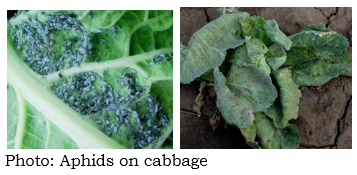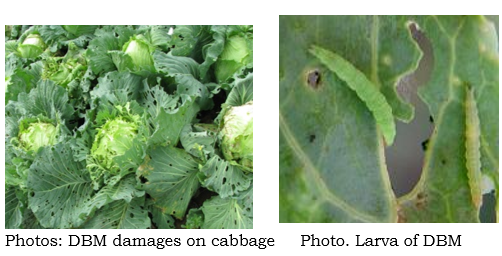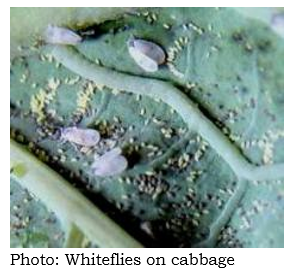Harvesting and yield
Cabbage is often hand-harvested when heads are firm to the touch but before cracking begins. With hand harvesting, a given field is harvested two to four times to obtain heads of uniform size and maturity. Only one to three harvests of hybrid cultivars are required because of their greater uniformity. Use of uniform transplants and consistent growing conditions also helps reduce the number of harvests.
Yields will vary with the season of production, cultivar, and production system used. With proper management, cabbage can produce 25-30t/ha.

Management:
- Intercrop with onion, garlic, spider plant, coriander to attract natural enemies.
- Avoid too much N.
- Plant in a well prepared fertile seedbed to promote crop vigour.
- Keep the fields free of weeds and alternative hosts.
- Manage the field to favour natural enemies such as lady bird beetles and hover flies.
- Mulch with wheat/rice straw or clear/transparent polyethylene sheet as reflectors of UV light discourage aphids from landing on the crop
- Use overhead irrigation to knock aphids off the leaves
- For chemical control, spray insecticides like Cypermethrine, Roket,etc.
Diamond back moth (DBM) (Plutella xylostella)
DBM is a serious pest of Brassicas and attacks all Brassica species. A full grown diamondback caterpillar is about 1cm long.Young larvae feed on leaves, leaving intact parchment like epidermis. Growth of younger seedlings is inhibited and also produces holes in leaves.

Management:
- To control DBM in small size farms, cover seedlings with row covers (fine nylon mesh) to prevent moths from laying eggs on the leaves and or next to the plant.
- Intercropping Brassicas with repellent plants such as tomato, reportedly reduces DBM infestation in cabbage. When intercropping with tomato, the cabbage crop is planted 30 days after tomato.
- Biological control of DBM using parasitoid wasp Diadegma semiclausum has proven very effective in the highlands of Kenya, Tanzania and Uganda.
- Botanicals such as neem-based pesticides are very effective for control of DBM.
- Physical protection method: dense planting of maize or sorghum around the field like a fence may be effective because the insect cannot fly over the maize and sorghum.
- Chemical control: Cypermethrine based chemicals like DUDU-CYPER and ROKET (at 1ml/1L of water) may be effective. But insecticide application is less effective for egg, mature larvae and pupae.
Whitefly (Aleyrodes proletella)
Whiteflies (Bemisia tabaci, Trialeurodes vaporariorum and Aleyrodes proletella) feed on Brassicas. Adult whiteflies are about 1 mm long.

Management:
- In East Africa, whitefly populations on Brassicas usually do not build up to such an extent that control measures are required.
- Natural enemies such as ladybird beetles, predatory mites and lacewings can play an important role in reducing whiteflies
- Proper fertilizer application because application of high doses of nitrogen fertiliser favours development of the pest
Use mineral oils, neem products or spray with soapy water solutions